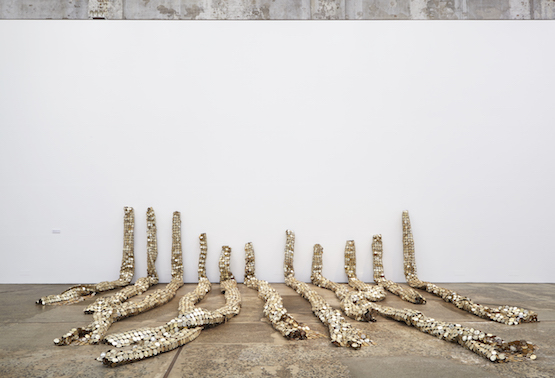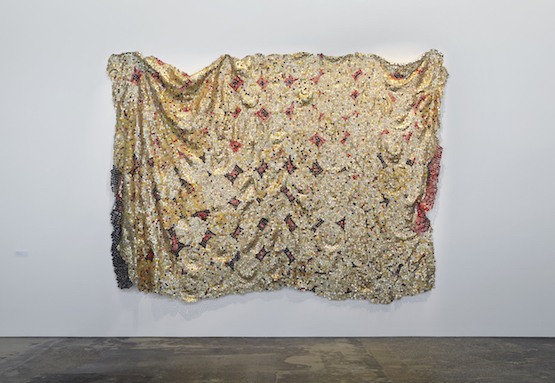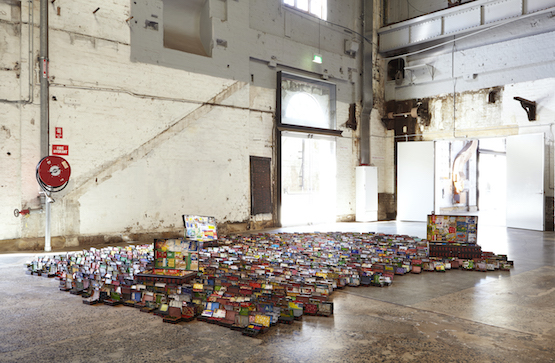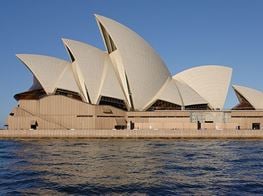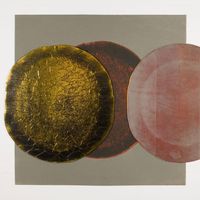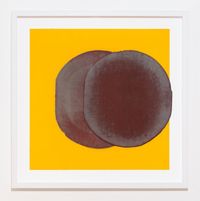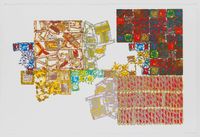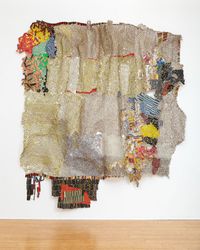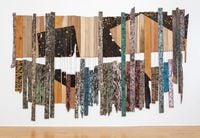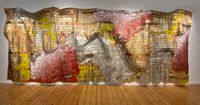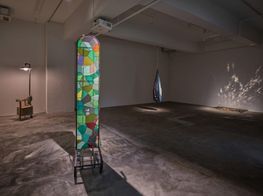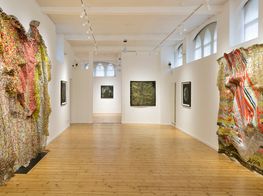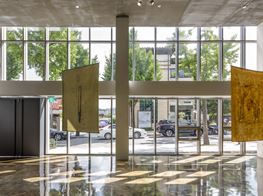'El Anatsui: Five Decades' at Carriageworks, Sydney

El Anatsui. Courtesy October Gallery, London. Photo: Andy Keate.
'Michelangelo's David has been stuck in that stance for centuries,' says El Anatsui. It is a comment that helps to explain at least one of the primary concerns of Anatsui's 50 career.
'At art school I was very struck by how some art works are so fixed. And I thought that if art is something that replicates life, or if art is life, life is not a static thing, it is a dynamic thing. So art should have that property as well. It should be able to contract, be able to expand, to do anything that the circumstances provide'.
Currently showing at Carriageworks, El Anatsui: Five Decades (7 January to 6 March 2015) is a retrospective exhibition of over 30 works by this 2015 Venice Biennale Golden Lion winning African-born artist. From his trademark bottle cap installations to early ceramic pieces and wooden figures Five Decades provides the viewer with an understanding of the depth present within the re-occurring themes of Anatsui's practice.
Of the utmost concern to Anatsui is that a work must be fluid and free, it must embody the change inherent to every day life. As Anatsui says, 'The form is not a given, but it is a proposition'. Even his earlier pieces in wood, such as Devotees (1987) and Group Photo (1987), were never static but were sculptural pieces open to ever changing configurations. Similarly, his bottle cap, tapestry-like installations arrive at museums around the world with very little instruction.
As Carriageworks curator, Beatrice Gralton, comments, 'One of the privileges and indeed, the challenges of working with El's work, is that he allows the curators and the installation staff an extraordinary amount of freedom when it comes to the installation of his work. This is both hugely generous and incredibly daunting as every fold and crush has to be carefully deliberated upon. Or, as El said, not too carefully'.
Included in_Five Decades_ are a number of Anatsui's bottle cap installations that appear as great swathes of material, mounted on walls or strewn across the floor. They are sumptuous works and certainly the souring railway warehouses of Carriageworks provide an appropriate level of scale for the monumental pieces.
Anatsui sources the bottle caps from his home country in Nigeria, flattens the lids and pieces them together using copper wire. Anatsui has developed over multiple techniques of flattening and joining the individual pieces and as such the works can vary incredibly.
For example, Awakened (2012) appears as a block colour flag in a process of unravelling whereas Blema (2006) utilises the gilt round tops of the lids and as such embodies a weight and luxury akin to a king's royal robe. In contrast again, Stressed World (2011) is cartographic, a map of an unknown state gaping at the centre as if a wildfire has torn through, leaving but a skeletal frame in its wake.
There is a tension present in all of Anatsui's work and one embodiment of that push and pull appears to be that of how the individual operates within the mass. The genesis of the bottle cap installations is well known in that in 1998 Anatsui was searching for objects near his home when he came across a bag of bottle caps lying beneath a bush. The lids lay dormant in his studio for almost two years until Anatsui started to ask some questions of the medium. 'I thought ok, as individual bottle caps you don't mean anything but if you put them together in one mass you will probably have something to say. That is how the whole thing started', says El.
Another element present in Five Decades is Anatsui's reoccurring reference to funerals that again could be seen as an investigation into the amassing of individuals and how they operate as a whole. Both Waste Paper Bags (2004-2010) and Blema (2006) stem from the ceremony and language of the funeral.
They are an interesting pair of works to see in relation to one another as Blema (2006), on the one hand, appears as a wall-mounted shimmering gold cloth. Waste Paper Bags (2004-2010), in comparison, is rooted in the floor, the sculptures are over-sized shopping bags toppled and crumpled, the scene akin to paper mâché rubbish bins pasted with aluminium foil.
And yet both pieces direct the viewer towards the funeral.Blema (2006) displays the repeated form of the concentric circle, a major symbol of the body of signs in Ghanaian culture used in regards to funerals or 'saying farewell'. It is a symbol often displayed upon Ghanaian funeral cloths in order to prompt reflection in the individual present at the funeral.
In addition,Waste Paper Bags (2004-2010) is constructed from aluminium printing plates originally used to publicise obituary notices. As Anatsui explains, 'Because in my part of the world funerals are big, public events. Because the public has to come to support and mourn as well. So you have to do real publicity so that as many people as possible know about it and can come to participate'.
The tension between the two works hangs in the private and public contemplation of life and death. In Blema (2006) the language is of the individual reflecting internally on the loss of a life. In Waste Paper Bags (2004-2010)__Anatsui uses the text of the public invitation to the funeral, the gathering of many people in order to celebrate and mourn one's life. As such Anatsui succeeds in mirroring the energy present internally and externally within the ceremony of the funeral.
Further, the funeral appears to be an appropriate metaphor for the concerns of Anatsui's art practice. The funeral is about a coming together of a group of people for an individual. It is about movement, a change of form, a transferral of energy. The ceremony itself contains an element of absolute universality; a funeral is able to be understood by every culture. Most importantly, death is the one inevitable, unavoidable change. But death is not a full stop in the work of Anatsui, but rather it is the making of space for something new.
'Waste Paper Bags travelled to so many venues it developed creases and cracks. It has been to about 14 different venues. So after two to three venues more layers are added. In the process most of the obituary notices have been covered up with other printing plates', explains Anatsui. 'In other words, I have kind of re-buried the people who were announced in these notices, but in a monumental way, because they have been taken around the whole world', adds Anatsui with a smile. —[O]



